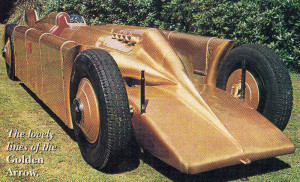 Back in 1929, speed was the thing. Land-speed records were attacked all the time by determined men of many countries.
Back in 1929, speed was the thing. Land-speed records were attacked all the time by determined men of many countries.
In that year, the world record of 207.55 mph was held by American Roy Keech with his monster 81 -litre, triple-engined Triplex Special.
The British were determined to beat this and Sir Henry Segrave set about getting a car to do just that. Henry Segrave was a man dedicated to speed. He was born in Baltimore,
USA, but was educated in England at Eton and Sandhurst. At the outbreak of the First World War, he went into the Royal Flying Corps and was wounded in 1916.
He then became secretary to the Air Minister. He was demobbed with the rank of major and, like many other young men of his generation, became obsessed with speed, becoming a champion racing driver.
He competed in many events, winning the French Grand Prix in
1923 and the Spanish Grand Prix in
1924 in which he was the first motor racer to wear a crash helmet.
He won the annual 200-mile races
at Brooklands three times. In 1926, he became associated with Sunbeam cars and broke the land-speed record at 152.33 mph. On March 29th,
1927, he became the first driver to exceed 200 mph driving a 1,000 hp Sunbeam with an aircraft engine. In 1929, determined to beat the record yet again, a new car was produced which was a revelation. It was a Sunbeam designed by J. S. Irving and was built at Putney Vale, London, with beautiful streamlined bodywork in
gold aluminium produced by Thrupp and Maberly.
The car had a twelve-cylinder Napier-Lion aero-engine of 930 bhp Schneider Trophy type and was named the Golden Arrow.
Segrave took the Golden Arrow to Daytona in March of 1929 and, after just one practice-run behind him, went for the world speed record. The car easily took it, travelling at 231.45 mph. The superb design and streamlining had paid off and Britain
once again held the land speed record.
The Americans were determined to regain it and. two days later, brought out Keech’s Triplex Special, this time with Lee Bible at the wheel.
Unfortunately, the attempt had tragic consequences for the car went out of control at 200 mph and the driver was thrown out. It careered on and killed a photographer who was standing at the end of the run.
Segrave then turned his attention to speedboats and won the International Championship at Florida in 1928.
Now out to beat the water speed record, he went to Lake Windermere for trials with his boat, Miss England II. He actually set a new record of 98.76 mph on the first trial but tragedy struck. The boat capsized after striking a log and he was killed.
The famous record-breaking Golden Arrow had to be retired with only thirty miles on the clock. It was eventually put on display at the National Motor Museum at Beaulieu where it remains to this day, a gold-plated memorial to the great days of speed when Britain led the world.
Allan Warburton








